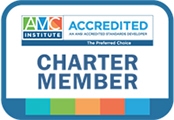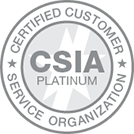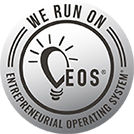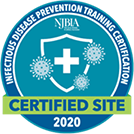Education Content Strategy for Associations: How to Create Member-Focused Learning

Why Associations Need an Education Content Strategy
Associations are uniquely positioned to serve as trusted sources of education. But in today’s competitive landscape - filled with content from industry vendors, academic institutions, and digital influencers - it’s harder than ever to stand out. A strategic approach to educational content helps associations demonstrate their value, strengthen member acquisition and retention, and maximize the return on their content investments.
Leading-edge education content is vital for member acquisition and retention
As bodies of knowledge, associations have much to offer members and prospects by way of expertise and education. However, with so much available on the market today from associations, industry, institutions, and other organizations, how do you make your content stand out? What’s more, how to ensure you that you maximize your resources and get the most out of your content?
An education content strategy is a critical planning tool that helps associations ensure that the educational content they develop resonates with their audiences, stands out in a sea of options, and reaps the best possible returns for the organization.
The following article by Amy Williams, CAE, MPA, IOM, AH’s Vice President of Sales And Consulting, outlines how AH staff worked with Client Partners to develop strategies around creating and delivering educational content that showcased their respective organizations’ expertise and became powerful member acquisition and retention tools.
Case Study: How NADCA Used VR to Modernize Learning
AH client partner, NADCA, the HVAC Inspection, Cleaning, and Restoration Association, introduced a hotly anticipated virtual reality (VR) training into its educational offerings, creating an immersive learning experience that provides real-life scenarios without requiring the user to do anything more than put on a headset.
NADCA’s VR training experience was developed to give newer technicians in the air duct cleaning industry an opportunity to experience a job site before actually going to a job site - it introduces them to a commercial mechanical room and walks them through the process of identifying components of the system all while wearing the headset and sitting in the comfort of a cushioned-swivel chair.

The VR training is used in conjunction with the current certification training for NADCA’s two certifications, the Air Systems Cleaning Specialist (ASCS) and Certified Ventilation Inspector (CVI). It is also used at NADCA’s two annual events, the Annual Meeting & Exposition, and the Fall Technical Conference. The VR training was available for all attendees to try at its launch, but it is specifically developed for the ASCS training course, which is included as a pre-meeting opportunity for both events.
AH staff sourced VR vendors and worked with members to identify the duties they perform in the field that would be most beneficial to see in a virtual environment. NADCA’s Education Committee then selected three volunteers to serve as subject matter experts throughout the development process. Staff project managed the process, secured talent for filming, and worked with the volunteer SMEs to ensure that the technical process and voiceover content was correct.
Building a Scalable Technical Content Strategy at JPMA
The Juvenile Product Manufacturers Association (JPMA) develops its technical content in three ways:
- An independent contractor who is a subject matter expert in child safety is engaged in a near-full-time capacity related to his area of expertise. He functions as a full staff member reporting to the Executive Director including developing tactics to support board strategy, oversight of the committee related to his functional area and accountability for related budget line items. He speaks for JPMA in public affairs matters related to his field and advises the Executive Director on technical matters.
- Subject matter experts from within the membership and broader stakeholder groups are engaged to write blogs and other articles, act as committee chairs, provide comments on testimony or other position statements and serve as association liaison on national and global standards-setting committees. Most of this engagement is volunteer but sometimes a stipend or expense reimbursement is provided.
- In areas of high activity and need, AH staff has developed technical expertise in required areas so that the association has its own staff experts. This is accomplished through educational programs paid for by JPMA and sometimes as a shared expense between AH and the association. JPMA’s staff experts are considered integral and respected participants of the industry community.
Cross-Committee Collaboration for Educational Success at PPS
The Private Practice Section of the American Physical Therapy Association (PPS) provides education to its members through three different conferences, multiple publications, and online webinars conducted year-round. PPS use several different committees to develop this content.
Each conference has its own program work group that is charged with selecting content specifically for their respective conferences. They use an abstract submission process to solicit proposals, and then use a formal review process to help make the final selections. The committee uses conference evaluations from each year to improve the next year's conference and/or identify future content needs.
The Education Committee helps to identify content for online webinars, and they regularly review PPS publications and the online learning center for accuracy/timeliness. If a publication needs to be updated, they appoint an editor (and additional writers as needed) based on the expertise required for that particular publication. For webinars, Education Committee Members will help identify speakers who are qualified to speak on that topic or review proposals that are received.
PPS conducts a biennial membership survey which includes several questions related to educational needs. All content committees (Education Committee and the workgroups) use that data to assess content being provided and ensure member needs are met.
PPS also employs several methods to ensure that these various groups work with one another:
- Each committee has a board member liaison who attends committee meetings and can report back to the board as needed. This helps to ensure at the board level that there is cohesion and knowledge of all activities.
- The PPS Education staff member is the staff liaison to each of these committees. The staff liaison is not the content expert, but rather works to promote and execute the various conferences and webinars, and also ensure that the CEU requirements are met. Since the same staff member works with each of those committees, she is an excellent go-between, and can help ensure that the work of the various committees is complementary but not duplicative. The committees are also able to leverage content from one group to the next. For example, for their annual conference, PPS is only able to accept about one-third of the total submissions they receive. That means PPS often has excellent submissions for which there is no room on the program. The Education staff member can then take that material to the Education committee for review and possible development in an online webinar.
- PPS regularly (about quarterly) convenes a meeting of the "Supercommittee," which consists of all committee chairs and the PPS Board, to discuss progress on the organization's strategic plan and coordinate ongoing efforts.
In terms of committee composition, PPS works to ensure diversity among the group in terms of location, practice type and size, specialty areas, age/experience, etc. This ensures that the committees represent multiple perspectives and that they know different people. Some of them are content experts themselves, but many are not. We look for highly engaged, connected members, who are attending PPS (and other) conferences and therefore know people and can help make connections and find the experts for the needed topics.
How ASHT Develops and Delivers Targeted Educational Content
The American Society of Hand Therapists (ASHT) offers numerous education offerings that are developed in partnership between staff and volunteers.
Webinars
A key source of relevant content are ASHT monthly webinars and vendor-led (sponsored) webinars. This content is offered live and then added to ASHT’s online store for purchase.
Content and speakers are identified via an online application portal as well as member/volunteer referrals. Staff has also developed webinar content by working with individuals who have presented effective sessions at our annual meeting.
A volunteer-led project team evaluates webinar applications (including a preliminary presentation), reviews the content, and offers feedback and recommendations. Revised presentations are then re-reviewed to ensure quality and relevancy.
Attendees receive CEUs by passing an online quiz and must complete an online course evaluation in order to print their CE certificate.
Development of New Courses
In the past couple of years, ASHT has developed and launched several successful new programs that were created based upon data-driven feedback from members and course attendees. Member services inquiries are directed to the Education inbox. Course evaluations are required for all course and webinar attendees. Both of these avenues resulted in insightful information about needs and wants, which ASHT acted upon quickly by developing new content, as shown below:
Novice Therapists and Students
Consistent feedback was given on the need for courses and programs directed to the novice hand therapist and students. As such, ASHT developed the Upper Extremity Institute, an online study group for the novice therapist. The Institute is a members-only benefit that is offered free to our membership. The course consists of monthly webinar sessions on various topics relevant to newer therapists. Content is developed from a project team and goes through a rigorous review process to ensure relevancy.
ASHT staff also developed a web page containing resources for the novice therapist. And they launched a Student Center component to our website with resources and an online assessment exam geared toward students.
Traveling Course
A few years ago, ASHT launched a “traveling course” that consists of approved courses that are presented at a host site upon request. Content is obtained via an online course application portal, where a therapist may submit a topic for a course they’d like to develop. A project team reviews the course application (objectives, presentation, etc.). The course is presented as a live, lecture-based course at various host sites throughout the country, upon request.
Podcast
ASHT’s Education Division developed a bi-weekly podcast informed by member feedback and surveys, which identified the need for relevant content to be delivered in a periodic, brief and digital format. ASHT also has a Tech & Communications Committee that helps to source and identify new technologies to provide content. A podcast project team identifies two volunteers to host the series and develops topics and content to share on each episode.
Portfolio Management: Optimize Your Educational Content Offerings
Portfolio Management refers to the practice of managing an organization’s products to ensure the right mix of offerings in view of organization objectives, financial goals and stakeholder value. Organizations should regularly review their educational and content offerings through several different lenses to ensure a balanced mix and fill gaps across several criteria:
- What product lifecycle phase does this offering fall into – is it in its Introduction, Growth, Maturity or Decline phase?
- Who is the target audience – what industries or positions does the content appeal to?
- What career stage is it geared towards – early-, mid- or senior-career stakeholders?
- What topical area or Body of Knowledge domain does the content fall under?
- What platform is used to deliver the content – webinars, podcasts, self-study, workshops, virtual or in-person conferences?
- How profitable is the product – profitable, break-even, or a mission-driven expense?
- What is the demand for the product – increasing, steady, high, declining?
- What is the value stakeholders get from the offering – high, moderate, low?
Regularly reviewing educational content through these lenses allows an organization to make data-driven decisions when developing new products to fill gaps, modifying existing products to better meet stakeholder needs, and retiring old products that are no longer meeting needs.
Key Takeaways for Building Your Association’s Education Strategy
Education is at the core of what many associations do - but content without strategy is just noise. Whether it’s deploying cutting-edge VR training, leveraging volunteer expertise, or managing a balanced portfolio of learning formats, your strategy should always center on member value and mission alignment.
Associations that invest in a thoughtful education content strategy don’t just inform, they engage, inspire, and grow their communities.
Ready to partner on your association's content strategy?
Email us at inquire@ahint.com.



